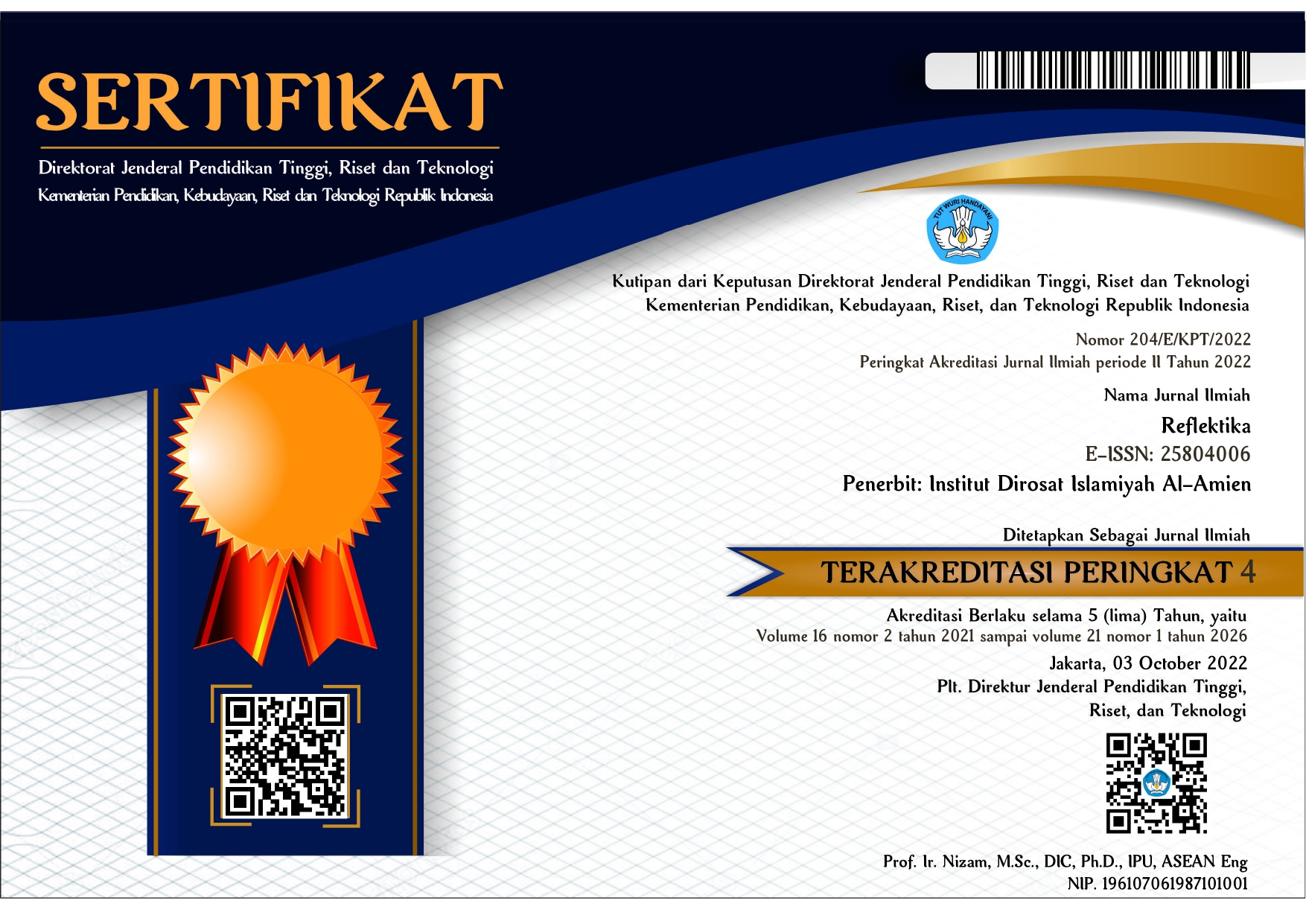STRUKTUR SURAT AL-HIJR PERSPEKTIF SEMITIC RHETORICAL ANALYSIS (SRA
Abstract
The Quran contains verses and letters that are systematically and coherently structured, as supported by al-Zarkashi and al-Suyuti. But Richard Bell took a different view. For example, according to him, the letter Al-Hijr needed to be more systematic, and there were some errors in laying verses. Meanwhile, Michel Cuypers is serious about the Semitic Rhetorical Analysis (SRA) approach in analyzing the structure of the Qur'anic text to find a concentric, mirror, and parallel symmetrical patterns in the form of the Qur'anic text. Even this approach is Considered a modern methodology with a new type of dialogue. It is interesting to look for bright spots in the structure of surat al-Hijr from the perspective of SRA. So that raises the question of what is the form of the text of surat al-Hijr from the standpoint of SRA. A Semitic Rhetorical Analysis (SRA) approach is used to answer this question. That is by analyzing the pairing pattern of the text of surat al-Hijr so that it forms groups of text at the bottom level. The bottom level has reanalyzed the design to get groups of text at the level above it, and so on, until the top level is obtained, namely surat al-Hijr. This article concludes that SRA, according to surat al-Hijr, is a Book consisting of 13 Sections arranged in a concentric symmetrical pattern (A-B-C-B*-A*). Richard Bell's opinion is refuted because each verse in surah al-Hijr is capable of symmetry with other poems from the lowest level of the text to the top level, so this conclusion indicates that surat al-Hijr is systematically and Coherently arranged.
Â
Keywords
References
Abu Hayyan. Tafsir al-bahr al-Muhit. Beirut: Dar al-Kutub al-‘Ilmiyyah, 1993.
Ajhuri (al), ‘Atiyyah ibn ‘At}iyyah. Irshad al-Rahman li Asbab al-Nuzul wa al-Nasikh wa al-Mansukh wa al-Mutashabih wa Tajwid al-Qur’an. Beirut: Dar ibn Hazm, 2009.
Asnawi, Aqdi Rofiq. Mengenal Semitic Rhetorical Analysis (SRA) dalam Kajian Al-Quran Kontemporer. Malang: Literasi Nusa Abadi, 2022.
______. Koherensi Struktur Teks dalam Penafsiran Al-Quran Perspektif Semitic Rhetorical Analysis (Studi Kritis Atas Interpretasi Al-Quran Michel Cuypers), (Disertasi—UIN Sunan Ampel, Surabaya, 2022).
______ “Penerapan Semitic Rhetorical Analysis pada Surah al-Qiyamahâ€. Mutawatir, vol. 8, No. 1, (Juni 2018).
______“Re-analyzing the Structure of Surah al-’Alaq Using Semitic Rhetorical Analysis (SRA): a critical Study on Cuypers’ Methodology of Analyzing Qur’anic Structure,†QURANICA International Journal on Quranic Research 13, no 1 (2021).
Attallah, Halla. “Michel Cuypers, The Composition of the Qur’an: Rhetorical Analysis, translated by Jerry Ryan. (London-New York: Blomsbury Academic, 2015,†Der Islam. Vol 95, no. 1 (2018).
Bell, Richard. The Qu’ran, Edinburg: T.&T Clark, 1937.
Cuypers, Michel, 2007, Naz}rah Jadidah fi Naz}mi al-Qur’an,Terj. Yusuf Habib Naqulan Habib, al-‘Ulum al-Islamiyyah wa al-‘Arabiyyah wa Qad}aaya al-I’jaz fi al-Quran wa al-Sunnah, (Kairo).
_______“Semitic Rhetoric as a key to the Question of Nazm of the Quranic Text,†Journal of Qur’anic Studies, Vol 13, no 1 (2011).
_______The Banquit: A Reading of the Fifth Sura of the Qur’an, Terj. Patricia Kelly. Florida: Convivium Press, 2009.
______The Composition of The Qur’an: Rhetorical Analysis, diterj. Jerry Ryan. London, New York: Blomsburry Academic, 2015.
______Fi Naz}mi Surah al-Ma’’idah: Naz}m Ayi al-Qur’an fi D}aw’i Manhaj al-Tahlil al-Balaghi . Terj. ‘Amr Abdul ‘Ati Salih. Beirut: Dar al-Mashriq, 2016.
______A Qur’anic Apocalupse: A Reading of the Thirty-three Last Surahs of the Qur’an. Terj. Jerry Ryan. Atlanta: Lockwood Press, 2018.
______Fi Nazm al-Qur’an. Terj. ‘Adnan Muqrani dan Tariq Manzu. Beirut: Dar al-Masyriq, 2018.
Farrin, Raymond. Structure and Qur’anic Interpretation: A Study of Symmetry and Coherence in Islam’s Holy Text. Ashland, Oregon: White Cloud Press, 2014.
Harun, Salman. Kaidah-Kaidah Tafsir. Jakarta: QAF, 2017.
Hawwa, Sa’id. Al-Asas fi al-Tafsir. Kairo: Dar al-Salam, 1424.
Jabiri (al), Muhammad ‘Abid. Fahm al-Qur’an al-Karim al-Tafsir al-Wad}ih Hasba Tartib al-Nuzul. Maroko: Dar al-Nashr al-Maghribi, 2008.
Meynet, Roland, dkk. Tariqat al-Thalil al-Balaghi wa al-Tafsir. terj. Jawjarah Hardan dan Hanri ‘Uways. Beirut: Dar al-Mashriq, 2004.
Mokrani, Adnane, 2019, “Semitic Rhetoric and the Qur’an: The Scholarship of Michel Cuypers, “New Trends in Qur’anic Studies: Text, Context, and Interpretation, ed. Mun’im Sirry (Atlanta, Georgia: Lockwood Press).
Razi (al), Fakhr al-Din. Tafsir al-Fakhr al-Razi al-Mushtahar bi al-Tafsir al-Kabir wa Mafatih al-Ghoib. Beirut: Dar al-Fikr, 1981.
Robinson, Neal. Discovering the Qur’an: A Contemporary Approach to a Veiled Text. London: SCM Press, 1996.
______ “The Structure and Interpretation of Sūrat al-Mu'minūn,†Journal of Qur'anic Studies, vol. 2, no. 1 (2000).
______“Hands Oustreched: Towards a Rereading of Surat al-Ma’ida,†Jounal of Qur’anic Studies, Vol 3, No. 1 (2001).
______“Surat Al- ‘Imran and Those with the Greatest Claim to Abraham,†Journal of Qur’anic Studies, Vol. 6, No. 1 (2014).
Qat}t}an, Manna’. Mabahith fi ‘ilm al-Qur’an . Kairo: Maktabah Wahbiyyah, t.th.
Quran (al), Lajnah Pentashihan Mushaf. Al-Qur’an dan Terjemahannya Edisi Penyempurnaan 2019. Jakarta: Badan Litbang dan Diklat Kementrian Agama RI, 2019.
Sinai, Nicolai. “Review Essay: ‘Going Round in Circles’: Michel Cuypers, The Composition of the Qur’an : Rhetorical Analaysis, and Raymond Farrin, Structure and Qur’anic Interpretation: Study of Symmetry and Coherence in Islam’s Holy Text,†Journal of Qur’anic Studies 19, no. 2 (2017).
Shinqiti (al), Muhammad al-Amin. Ad}wa’u al-Bayan fi Id}ah al-Qur’an bi al-Qur’an. t.tp: Dar ‘Ilm al-Fawaid, t.t.
Suyut}i (al), Jalal al-Din. al-Durr al-Manthur fi al-Tafsir bi al-Ma’thur. Kairo: Markaz Hijr, 2003.
______al-Itqan fi ‘Ulum al-Qur’an, vol. 3. Kairo: al-Hay’ah al-Mis}riyyah al-‘Ammah li al-Kitab, 1394 H.
______Lubab al Nuqul fi Asbab al-Nuzul. Beirut: Mu’assasah al-Kutub al-Thaqafiyyah, 2002.
______Maras}id al-Mat}ali’ fi Tanasub al-Maqat}’wa al-Mat}li’. Riyadh: Maktabah al-Minhaj, 1426 H.
______Tanasuq al-Durar fi Tanasub al-Suwar. Beirut: Dar al-Kutub al-‘Ilmiyyah, 1982.
Wahidi (al), ‘Ali bin Ahmad. Asbab al-Nuzul al-Qur’an. Beirut: Dar al-Kutub al-‘Ilmiyyah, 1991.
Zahniser, Matthias. “Major Transitions and Thematic Borders in Two Long Sūras: Al-Baqara and al-Nisa’,†Literary Structures of Religious Meaning, ed. Issa Boullata. Richmond: Curzon Press, 2000.
Zamakhshari (al). Al-Kashshaf . Riyadh: Maktabah Obekan, 1998.
Zarkashi (al), Badr al-Din, Al-Burhan fi ‘Ulum al-Quran, vol 1. Beirut: Dar al-Ma’rifah, 1957.
DOI: 10.28944/reflektika.v17i2.816
Refbacks
- There are currently no refbacks.


.png)

